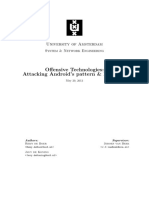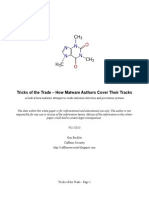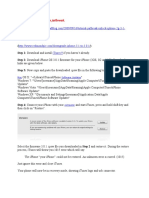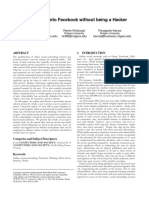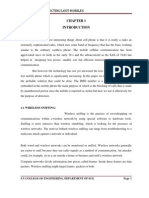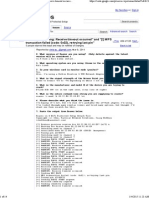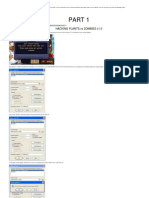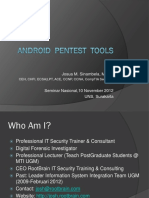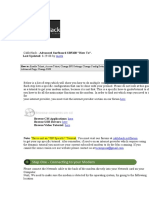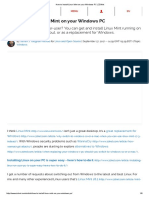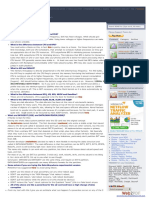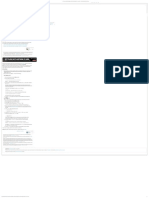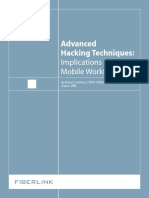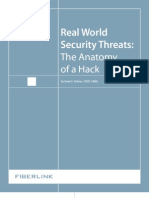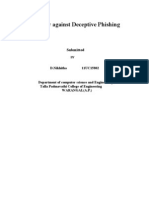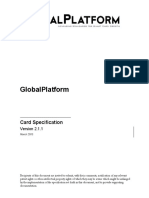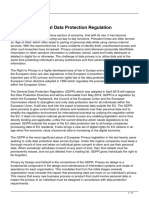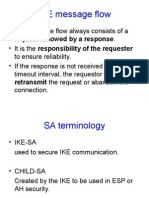Hack2-CompGde-081706.
qxd
8/17/06
4:14 PM
Page 1
Advanced
Hacking Techniques:
Implications for a
Mobile Workforce
By Daniel V. Hoffman, CISSP, CWNA, CEH
August, 2006
�Hack2-CompGde-081706.qxd
8/17/06
4:14 PM
Page 2
1
CONTENTS
Introduction
The Changing Threat Landscape
Step-by-Step Guide: Hacking the
Mobile Workforce
Security Fundamentals: Rethink Your Security
Strategy with the Mobile Worker in Mind
Sponsor Perspective:
Fiberlink: Simple. Secure. Mobility.
DEMONSTRATION
Click here to view the demonstration:
Hacking the Mobile Workforce
2006 Fiberlink Communications, Corp.
�Hack2-CompGde-081706.qxd
8/17/06
4:14 PM
Page 3
2
EXECUTIVE SUMMARY
Laptops are being deployed within enterprises at an
increasing rate, mostly because of the flexibility and
convenience they provide employees, and in turn, the
productivity gains they provide for the companies.
Its impossible to go anywhere today without seeing
people working outside the traditional office setting on
their laptops - at the local coffee shop, while lounging in
the park, standing at their kitchen counters, waiting at
airport gates, and working in their hotel rooms. Gone are
the days when
people worked
from 9:5 at
86% of employees in the United States
the office. As
will be working on laptops by 2007.
Gartner Research
John Girard
stated in a
report on
Managing the Mobile & Remote Wireless Workforce1,
during recent years, the volume of people working outside
the settings of central offices has risen steadily. No matter
where people are physically located, they are usually
involved in remote work. Their outputs, collaborations,
meetings and styles are characterized by interactions
that are electronic, not face-to-face.
Some interesting market trends also support this
same point:
By 2008, 75% of the sales and services workforce
worldwide will be mobile. (Gartner)
In May 2005, notebook sales accounted for 53% of the
total U.S. PC market, outpacing desktop sales for the
first time. (Current Analysis, July 2005)
This shift in employee mobility has created a need to
redefine the mobile worker. No longer can a mobile worker
be defined solely as a road warrior, the traveling salesperson who spends upwards of 80% of their time on the
road going from airport, to hotel, to customer site, etc.
It may also be a teleworker someone who works
mainly from their home office and uses either a laptop
or sometimes even a personal PC. In todays business
environment, a mobile worker can be defined simply
as any user that has been issued a mobile computing
device, such as a laptop.
With the growth in mobile laptop usage comes a new set
of complexities for enterprises trying to make it simple
and seamless for their end-users to connect, while at the
same time, protecting their network, their assets and the
reputation of their business.
In November 2005, a Boeing Co. laptop with personal
information on 160,000 current and former employees
was stolen and never recovered.
DEMONSTRATION
Click here to view the demonstration:
Hacking the Mobile Workforce
2006 Fiberlink Communications, Corp.
�Hack2-CompGde-081706.qxd
8/17/06
4:14 PM
Page 4
3
THE CHANGING THREAT LANDSCAPE
When it comes to protecting data and devices, many IT
professionals say that it has become too difficult to keep
up. In other words, staying ahead of the security curve is
overwhelming, and many feel like they are not leading,
but rather responding or reacting. Conversely, there are
others that feel like they have it all covered. Their endusers arent complaining, their executives are happy, they
havent experienced any security breaches, and costs are
under control. In our first video analysis, Real World
Security Threats: The Anatomy of a Hack (12/2005),
Dan Hoffman (Systems Engineer) walked through three
primary network-based threats:
1. Credentials and data sniffing
2. Malware including viruses, worms, trojans, spyware
and adware
3. Direct attacks to computer system or network as a
result of deliberate action
The guide provided a thorough description of each type
of threat, and best practices for how to protect your
enterprise against that specific form of attack.
Gone are the
days of
random
experimentaJohn Pescatore, Gartner Research
tion and
information
vandalism for the pure enjoyment of publicity and notoriety.
Todays hackers are more motivated by quick financial
gain targeting specific industries or companies and
going after their valued data and information. They are
executing more cleverly than ever before to avoid detection.
Therefore, enterprises need more sophisticated security
processes, architectures and strategies to deal with
these attacks today, and in the future.
The major Internet threat that is on the
rise is the financially motivated, targeted
internal attacks.2
A recent Gartner study shows that viruses and worms still
top the list of threats that keep IT organizations up at night
with spyware and phishing in a close tie for second.3
Although most enterprises are aware of these sophisticated
Web-based attacks, the threat is as daunting as ever.
More than 59 million cyberassaults originate in
North America alone in an average 24-hour period.4
Consumer Reports, July 2006
The Disconnected Threat
In a 2005 FBI Computer Crime Survey, US companies
alone lost an estimated $67 billion due to computer
crimes (e.g., viruses, spyware, PC theft and other computer
crimes). This is despite the fact that virtually all of the
organizations surveyed used anti-virus software (98.2%)
and personal firewalls (90.7%). These losses are due to
the fact that traditional Internet security solutions are not
enough to handle sophisticated web-based threats.
Malicious code can easily navigate open ports, disable a
personal firewall and infect a network long before a
signature-based anti-virus fix is available, or a software
patch can be deployed.
One of the greatest challenges that IT faces is the multitude
of possible entry points for viruses, worms and other
malware to enter the network whether their mobile
users are connected to the network, or not. These
include: USB storage devices and iPods, laptop usage
outside the perimeter, non-network based wireless communication (e.g., Bluetooth) or careless acceptance of an End
User License Agreement can all expose the corporate
network to malicious code and jeopardize the safeguarding of corporate data.
And who can miss the headlines about the risks associated
with the physical theft or loss of laptops? If a laptop is
stolen or lost, corporate information and personal
information can be compromised at potentially catastrophic
levels - permanently damaging a business reputation and
leaving behind the residue of gross financial repercussions.
2006 Fiberlink Communications, Corp.
�Hack2-CompGde-081706.qxd
8/17/06
4:14 PM
Page 5
4
LAPTOP THEFT STATS
HACKING THE MOBILE WORKFORCE
97% of stolen computers are never recovered. (FBI)
Veterans Administration: A laptop was stolen in
May 2006, with Social Security numbers and personal
information for 26.5 million veterans. The VA offered
free credit monitoring services to those affected. (The
laptop was recovered in June, with no evidence that
the information had been copied.)
Ameriprise Financial: In January 2005, Ameriprise
Financial Inc. of Minneapolis had to notify 226,000
people that their names and other personal data was
stolen from a laptop left in an employees car.
Boeing Co: In November 2005, a Boeing Co. laptop
with personal information on 160,000 current and
former employees was stolen and never recovered.
In Fiberlinks latest video analysis, expert ethical hacker,
Daniel V. Hoffman, CISSP, CWNA, CEH demonstrates a
series of four modern-day attacks:
For more information on data breaches like these and
others, go to www.privacyrights.org.
Bottom line: Network-based security applications cant
protect mobile devices from all threats. A proactive and
pervasive security strategy is required to protect valuable
corporate assets against modern-day attacks.
Hack 1:
Hack 2:
Hack 3:
Hack 4:
Access Point (AP) Phishing, the Evil Twin
Vulnerable, Simply Surfing the Net
Unaware of Vulnerabilities at 30,000 Feet
Modifying Malware to Invisibly Bypass
Anti-Virus Programs
Each demonstration takes the viewer through a series
of steps that many hackers would follow to exploit
mobile and remote systems that lack the appropriate
security protection, and provides best practices on how
to safeguard your network.
Hack #1 AP Phishing, the Evil Twin
With the increase in mobile computing, more and more
workers are taking advantage of public Wi-Fi hotspots to
work anytime, anywhere they choose to stay productive.
Sometimes these locations require the user to pay for
Internet connectivity; others offer it for free. Enterprises
can no longer ignore end-users who bring their own
Wi-Fi connectivity - they need to take steps necessary to
proactively protect the laptops (endpoints) that are being
used to connect back to the corporate network for sensitive
data and resources.
In this hacking demonstration, better known as the Evil
Twin, a hacker creates a fake public Wi-Fi hotspot by
utilizing a readily available Access Point emulation program.
At this point, an unsuspecting end-user is tricked into
entering their username and password into a fake Wi-Fi
hotspot login page, where those credentials are stolen.
DEMONSTRATION
Click here to view the demonstration:
Hacking the Mobile Workforce
2006 Fiberlink Communications, Corp.
�Hack2-CompGde-081706.qxd
8/17/06
4:14 PM
Page 6
5
Consider the following preventative measures:
Deploy an intelligent, software-based client on all
laptops that has the ability to validate the authenticity
of a public Wi-Fi hotspot network.
Set policies that require an end-user to enter Wi-Fi
authentication credentials into an intelligent
software-based client that encrypts both the user name
and password, versus allowing the user to enter their
credentials into whatever HTML page happens to be
presented to them when they connect.
Hack #2 Vulnerable, Simply
Surfing the Net
It is virtually impossible for enterprises to keep up with
the ever-changing threat landscape. Most enterprises are
aware of the plethora of security patches, anti-virus and
anti-spyware updates that are made available on a daily
basis. However, the problem is that the highly reactive and
inside the LAN defenses that are employed by most
enterprises lack the systems necessary to ensure that
mobile devices receive these updates in a timely manner.
In addition, enterprises often lack the controls to prohibit
a user from surfing the Internet if their security posture
is deficient.
Hackers are highly aware of the gaps present in updating
mobile workers in a timely and persistent manner, and
they take advantage by performing hacks on mobile systems
that do not receive Internet Explorer security patches
quickly enough. As a result, the mobile system is
completely compromised.
Consider the following preventative measures:
Have policy enforcement logic reside on the
endpoint that prohibits a mobile user from surfing the
Internet if they are missing a security patch.
Remediate security deficiencies persistently and
in real-time by pushing security patches to the endpoint
anytime it is connected to the Internet. Employing a
system that supports seamless, real-time remediation
of vulnerabilities prior to VPN connectivity will ensure
your network will not be compromised, and your end-user
will remain productive.
Layer security by utilizing an enterprise-grade personal
firewall with IPS (Intrusion Prevention) functionality
that could stop a potential exploit from running on a
mobile system, even if it was not patched.
Hack #3 Unaware of Vulnerabilities
at 30,000 Feet
Airplane travel allows mobile workers to remain
productive, even when they are not able to communicate
with their co-workers and customers on the ground.
Today, most domestic flights dont generally provide
Internet connectivity, leaving most IT managers feeling
fairly confident that mobile workers are safe when
working in the air.
Unbeknown to most, however, workers utilizing a
Windows Operating System can find themselves at
significant risk because Windows does a poor job of
controlling non-network based access. For this hack
demonstration, HotSpotter passively monitors probe
frame requests automatically being sent by Windows XP
anytime the machine is powered ON. It then identifies
the preferred networks listed in Windows XP Zero
Config and utilizes that information to establish
network connectivity to a mobile users machine, in
an environment where no previous Internet-based
network exists. At this point, the mobile device can be
completely compromised by the hacker.
During recent years, the volume of people working outside
the settings of central offices has risen steadily.
John Girard, Managing the Mobile & Remote Wireless Workforce
2006 Fiberlink Communications, Corp.
�Hack2-CompGde-081706.qxd
8/17/06
4:14 PM
Page 7
6
Consider the following preventative measures:
Control network access by preventing mobile
devices from connecting to Wi-Fi networks unless
specifically initiated by the end-user.
Layer security by utilizing an enterprise grade personal
firewall with an intrusion prevention system (IPS) on
every mobile device. This will prohibit a hacker from
exploiting the machine.
Remediate security deficiencies in real-time by
pushing patches to a mobile endpoint anytime it is
connected to the Internet. Following this practice will
ensure that mobile systems will always have the latest
protection and be less susceptible to exploitation.
Hack #4 Modifying Malware to Invisibly
Bypass Anti-Virus Programs
Virtually all enterprises have anti-virus software installed
on their mobile systems. Most enterprises, however,
do not have the systems in place to ensure that the
anti-virus program is always running and up-to-date prior
to allowing an endpoint access to the corporate network.
Regardless, this hack will demonstrate how malware can
be modified to invisibly bypass two different anti-virus
programs. This hack will also demonstrate how important
it is to protect all mobile endpoints, even if those
endpoints are only connecting to the corporate network
via SSL VPN.
Consider the following preventative measures:
Layer security by utilizing anti-spyware and a
personal firewall with IPS functionality. Anti-spyware
solutions can catch modifications and installations of
malware that anti-virus systems might miss. Personal
Firewalls with IPS have similar functionality, with the
added benefit of prohibiting unwanted connections.
Also, the use of two-factor authentication for SSL
connectivity is becoming essential. A keylogger that
captures every key an end-user enters will not be able
to re-use those credentials to login themselves, if
two-factor authentication, such as RSA tokens,
are utilized.
Remediate security deficiencies in real-time by
ensuring that anti-virus and anti-spyware applications
are always running and have the latest definition
files installed prior to VPN connection back to the
corporate network.
US companies alone lost an estimated $67 billion due to
computer crimes (e.g., viruses, spyware, PC theft and
other computer crimes.) This is despite the fact that virtually
all of the organizations surveyed used anti-virus software
(98.2%) and personal firewalls (90.7%).
FBI Computer Crime Survey, 2005
DEMONSTRATION
Click here to view the demonstration:
Hacking the Mobile Workforce
2006 Fiberlink Communications, Corp.
�Hack2-CompGde-081706.qxd
8/17/06
4:14 PM
Page 8
7
SECURITY FUNDAMENTALS: RETHINK
YOUR SECURITY STRATEGY WITH THE
MOBILE WORKER IN MIND
Fundamental Change #1
Require your mobile endpoints to have the
same level of security as those devices that are
connecting to the network from inside the network
perimeter.
The reason for this is simple: at some point that endpoint
will connect back to the corporate network. Most IT
enterprises spend most of their time making sure security
is up-to-par on the machines that they see everyday (those
machines inside the perimeter), versus mobile laptops
which may leave the perimeter and not come back
for months.
Not unlike desktop PCs, laptops need comprehensive
mobile inspection systems to determine whether a device
seeking a network connection is really an authorized
device. It also requires that they are requesting tools that
monitor a device to see if it has up-to-date firewall,
anti-spyware and anti-virus settings, and all current software
patches. This level of security should be applied to reduce
risk, ensure business continuity and comply with government
regulations, irrespective of the actual threats.
Most enterprise IT departments would never dream of
tearing down hardware-based firewalls and IPS equipment
from their WAN. While at the same time, their mobile
systems are connected directly to the Internet and public
Wi-Fi hotspots, often without up-to-date personal firewalls
containing IPS functionality and without the necessary
security patches and anti-virus or anti-spyware updates.
97 percent of stolen computers are never recovered.
Federal Bureau of Investigations
Fundamental Change #2
Security policy enforcement logic needs to reside
on the endpoint.
Many companies are looking at solutions like Cisco
Network Admissions Control (CNAC) as the single source
to protect their corporate networks against threats.
Although a very strong solution for devices that are
connecting from inside the corporate perimeter, the good
and bad news is thats it NAC was designed to only
protect the inside: the LAN users, the corporate network;
not the mobile endpoint.
The checking of a laptops security posture and subsequent
remediation needs to take place on the endpoint,
whether the laptop is connected or not. If a mobile system
is missing a security patch that makes it vulnerable to an
exploit just for simply surfing the Internet, then that endpoint
should not be able to browse the Internet until it is
remediated with the proper security patch. Waiting until
that mobile system connects back to the corporate LAN
to receive that patch is simply too late by that time,
your network may have already been exposed.
Fundamental Change #3
Fixing security deficiencies needs to occur
automatically and persistently, in real-time.
Most of the time, mobile systems need to connect to the
corporate network to receive security patches, and anti-virus,
personal firewall updates, etc. This policy can leave the
mobile system vulnerable to exploits the majority of the
time they are physically away from the office. All anti-virus
updates and security patches must be pushed down to
the endpoint anytime they are connected the Internet, as
soon as they are tested and authorized by the enterprise,
and without end-user interaction or approval. In addition,
any security application that becomes disabled by malware
or an end-user must be automatically restarted to provide
the necessary level of protection.
2006 Fiberlink Communications, Corp.
�8
Fundamental Change #4
FIBERLINK: SIMPLE. SECURE. MOBILITY.
Layered Security is Essential.
No single countermeasure can protect a network from all
threats. Deploying multiple, integrated security measures
throughout the enterprise is your best bet to protect your
systems against threats to the enterprise. And dont be
fooled by claims made by SSL service providers, who tout
that browser-based VPN access back to the corporate
network provides all the security IT needs to protect your
network. VPNs (SSL or IPSEC) alone, while important,
certainly do not provide the security necessary to protect
a mobile device. Anti-spyware, personal firewall with
IPS, proper endpoint configuration and robust patching
and quarantining systems should all be required, and current,
on an endpoint.
Fiberlink delivers the software and services that make
mobile working simpler and more secure for todays
global enterprises. Since 1994, Fiberlink has earned a
reputation for being the trusted mobility expert for
demanding customers like GE, Bloomberg, and
Continental Airlines, as well as over 675 other mid to
large-sized companies.
Fundamental Change #5
Controlling Access is Crucial to Security.
Controlling access falls into three essential categories:
Ensuring that the access being provided is valid; (i.e.,
Evil Twin, AP Phishing).
Ensuring that connectivity to Wi-Fi hotspots occurs
only when desired and initiated by an end-user.
Ensuring that Internet and VPN connectivity only
occur when a mobile or remote system meets the
minimum-security requirements to establish this
connectivity.
DEMONSTRATION
Fiberlink has a legacy of offering solutions that
compliment the access component of mobile connectivity.
Though access remains an important service, Fiberlink
solves the challenges of securely managing mobile and
remote workers for IT, while simplifying the end user
connectivity experience.
Fiberlink developed Extend360 mobile access software
and its Dynamic Network Architecture PlatformTM (DNA)
to extend security, command and control over mobile
devices. This established a foundation for offering
broader solutions that deliver both access and endpoint
security and allowed Fiberlink to differentiate itself
from competitors.
With the demand for dial services declining and
trends towards free access, Fiberlink has focused
development on enabling and securing all forms of
access and offering valued-added services. Fiberlink
created the first solution that allows end users to
bring their own access but remain protected and
connected to the enterprise.
Customers are asking for IT solutions that provide
the ability to control who and how mobile users get
connected, along with better business intelligence,
through a control center portal. Fiberlink services are
focused on providing the avoidance of reputation risk,
asset risk, and network risk, using the command and
control features of the DNA Platform technology.
Click here to view the demonstration:
Hacking the Mobile Workforce
2006 Fiberlink Communications, Corp.
�Hack2-CompGde-081706.qxd
8/17/06
4:14 PM
Page 10
9
In addition, endpoint vulnerabilities are on the rise.
Fiberlink has created the ability to isolate and remediate
identified vulnerabilities before the user touches and
potentially exposes the LAN. With each new innovative
service offered, Fiberlink creates competitive advantages
over access providers, security point solutions and direct
competitors.
To view the live demonstration, Hacking the
Mobile Workforce, use the link below:
DEMONSTRATION
Fiberlink has been recognized by Gartner as a leader in
their 2006 Magic Quadrant for U.S. Managed Remote
Access and Mobility Services for the 5th consecutive
year. Click here to view the report.
SOURCES:
1) Managing the Mobile and Wireless Workforce, John Girard,
28 April 2004
2) Augment Security Processes to Deal with the Changing Internet
Threat, John Pescatore, 2 March 2006
3) Excerpt from Gartner RAS Core Research Note G00129419
User Survey: Security Summit Reveals Spending Patterns
Worldwide, 2005 Vic Wheatman.
4) Consumer Reports.org. State of the Net 2006, July 2006
2006 Fiberlink Communications, Corp.



